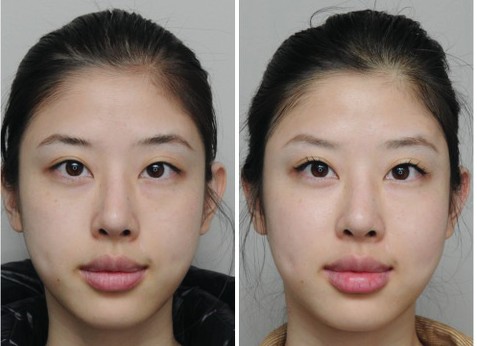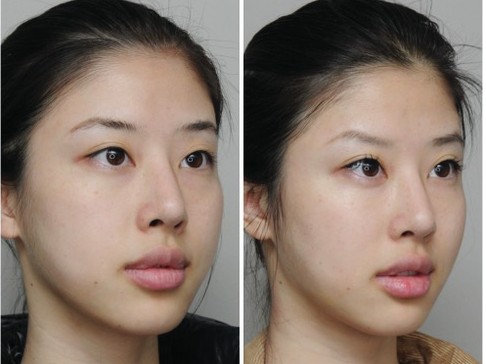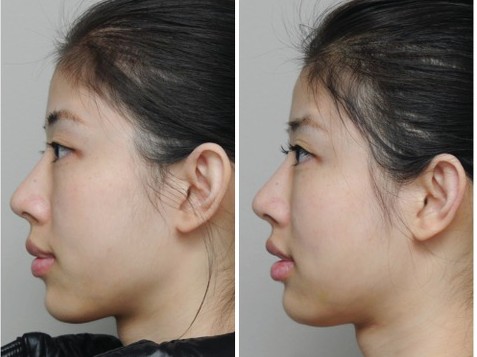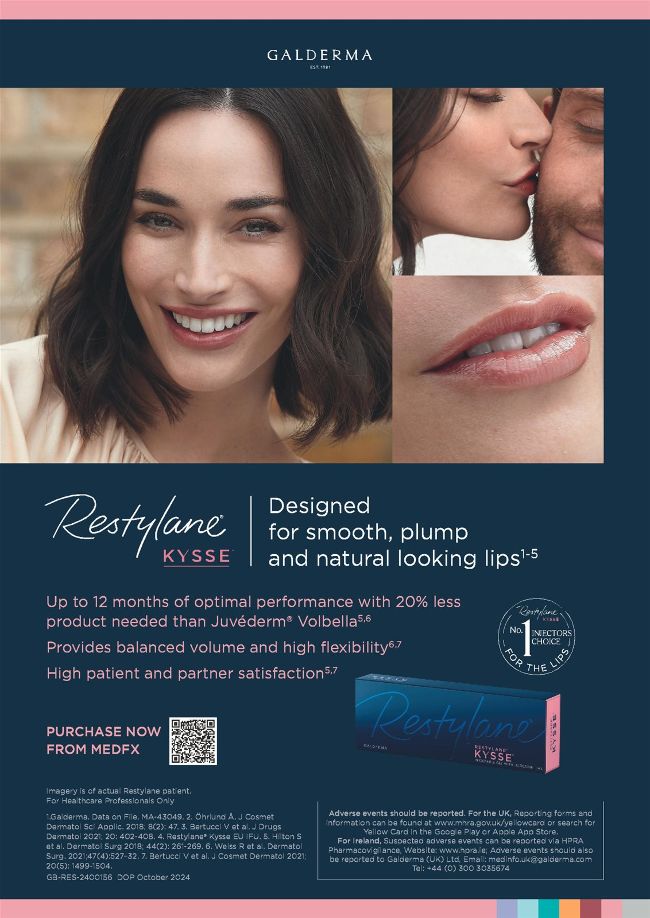CHINESE FEATURES
CASE STUDY: TREATING CHINESE FEATURES
Dr Mei Yeoh describes innovative approaches for treating Chinese patients in Western settings
Current aesthetic treatment guidelines, such as the MD Codes by Mauricio de Maio, are primarily tailored to Caucasian patients. However, there is a lack of specific protocols designed for Chinese patients, necessitating the adaptation of these guidelines to address the anatomical and aesthetic differences unique to this demographic. Chinese patients, for instance, tend to seek aesthetic interventions at a younger age than their Caucasian counterparts, typically focusing on early enhancement and beautification, while Caucasian patients often seek treatments for more pronounced, age-related concerns. Consequently, clinicians must modify existing protocols, which are not always optimal for addressing the distinct characteristics, needs, and expectations of Chinese patients.1
China officially recognises 56 ethnic groups, though some sources suggest that there may be more than 200. Each group possesses its own language, culture, traditions, and aesthetic ideals, contributing to the complex diversity within China’s 1.4 billion population. Despite this variety, certain key characteristics are generally observed in Chinese facial features. These include broader bizygomatic and bigonal dimensions, a retruded forehead, medial maxilla, pyriform margins, chin, and a low nasal bridge with minimal anterior projection. The proportions of the forehead, nose, lips, and chin are critical in shaping perceptions of facial attractiveness in Chinese individuals.2
Facial physiognomy is culturally significant in China, where particular facial traits are often believed to influence one’s fortune. An aesthetically desirable Chinese face is frequently described as having a long, narrow, and slender profile with a long philtrum, pointed chin, obtuse mandibular angle, and a straight or slightly concave nasal dorsum. The lips are typically narrow and thick, with the upper lip featuring well-defined Cupid’s bows that taper towards the oral commissures.2
The demand for cosmetic procedures is notably high among younger Chinese patients, particularly for nose and chin augmentations, which reflect priorities distinct from those of older individuals who often seek treatments for wrinkle reduction or facial sagging.3 As younger Chinese patients increasingly migrate to Western countries, it is crucial for clinicians to understand their aesthetic preferences and expectations. In the UK, the Chinese population encompasses individuals from varied backgrounds, including those raised in both Chinese and British communities, as well as those who have relocated later in life.
These groups, while sharing some common aesthetic ideals, also exhibit notable differences in their perspectives on beauty. Additionally, as the number of people of mixed heritage, such as those with both Caucasian and Chinese ancestry, continues to grow, the spectrum of aesthetic preferences becomes even more diverse
This case study will explore a treatment plan for a patient from China, studying in Leeds. They are Han Chinese.
CONSIDERATIONS FOR THE CONSULTATION
The consultation is a critical component of any patient journey, allowing us to identify the most appropriate treatments while gaining insight into the patient’s psychological motivations. In this case, the patient is from China, and her aesthetic ideals are shaped by South Korean influences rather than Western standards.
Had the patient been British-born Chinese, her beauty ideals might have been more aligned with Western concepts. It is essential to account for these subtleties when developing treatment plans for Chinese patients, as they represent a diverse demographic shaped not only by geographical factors but also by cultural and environmental influences.
This patient expressed a preference for a fuller upper face, a smaller, more rounded lower face, and a soft, non-angular appearance. These features are seen as an integral part of achieving the popular South Korean “baby face” look, characterised by plump, youthful, and delicate features.
She had previously undergone rhinoplasty in China, with her radix positioned at the centre of the pupil, which is consistent with Chinese aesthetic preferences. Chinese beauty standards often favour a nasion height of 8 to 10 mm, aligned with the centre of the pupil, whereas in Caucasian rhinoplasty, the nasion is typically positioned at the level of the upper lash line.4
The patient made it clear that she did not desire a “sculpted” look with high cheekbones or pronounced hollows, features commonly associated with Western ideals of beauty.
UPPER FACE CONSIDERATIONS
Aim: to increase fullness in temples and ensure a smooth transition from temple to cheek bone for a soft but full look.
Temples were treated with Stylage M 0.5ml each side anteriorly and Stylage L 0.5ml each side posteriorly in the subcutaneous fat (layer 2) with a 25g 50mm Precision32 micro cannula.
Micro bolus technique was used with afirm massage after treatment.
MIDFACE CONSIDERATIONS
Aim: to soften under eye transition to the midface, and to increase volume to the retruded medial midface.
The medial maxilla was treated with Stylage L, targeting the medial sub-orbicularis oculi fat (SOOF). In this unforgiving area, the choice of delivery device was critical. A precise injection technique was required, as only a small volume of product was needed in a high-risk area. A Precision32 25g 50mm microcannula was selected due to its close-to-tip exit port and smooth glide properties.
Given the limited injection techniques available for this region, I developed a new approach using a microcannula, drawing upon my anatomical knowledge and expertise in rheology.
The entry point was located at the lateral canthus, with the tip of the microcannula positioned at the medial iris. Micro boluses were injected while withdrawing the cannula towards the mid-pupillary line. Special care was taken to ensure placement remained above the infraorbital foramen (IOF). A total of 0.2ml of Stylage Lwas used. No filler was directly placed in the tear trough, as the patient did not present with a true hollow.
Illustration demonstrating the soft-tissue landmarks.
The oblique lines connecting the lateral canthus (LC) to the peak of the Cupid’s bow (CB) are indicated. IOF, infraorbital foramen; ML, medial limbus; M, midline (Colour figure can be viewed at wileyonlinelibrary.com)
LOWER FACE CONSIDERATIONS
High-intensity focused ultrasound (HIFU) was first applied to the lower face, with particular focus on the jowl area, as seen in the ¾ profile, to target superficial fat reduction and to make the transition from cheek to chin smooth. The 4.5mm and 3mm transducers were used at 1J, with 25 passes performed in each column.
Botulinum toxin type Awas injected into the masseters, with the injection points placed lower on the muscle and 25 units administered each side, supra periosteal. This approach helped maintain facial roundness and avoided preauricular hollowing.
For lip hydration, Hydromax was used, and Stylage Mwas placed at the oral commissures to provide support.
FINAL THOUGHTS
As the demand for aesthetic procedures increases among Chinese individuals in Western environments, it is crucial for healthcare professionals to adjust their practices to ensure that they deliver culturally sensitive treatments that align with their patients. For most Chinese patients, they want to maintain their Chinese appearance but enhance it, so they are a more refined and elegant version of themselves.

Anterior view: Temples widened, under eye hollowing reduced, lower face sharpened.

¾view: Cheek to chin line smooth (jowl reduced). Lower jawline reduced due to masseter injections and HIFU.

Side profile: Medial Maxilla volumised.
DR MEI YEOH
Dr Mei Yeoh’s career spans general dentistry and hospital-based practice, with extensive experience as a core trainee in maxillofacial surgery. She managed minor facial injuries and assisted in major surgeries, including jaw reconstruction, gaining deep expertise in head and neck anatomy. Trained by leading experts nationally and internationally, Dr Yeoh now focuses exclusively on aesthetic medicine and has been educating medical professionals since 2019. Arecognised speaker at national conferences, she is known for her contributions to advancing aesthetic medicine. She also has a strong interest in the development of aesthetic devices and technology.

REFERENCES
1. Chao, Yates &Chhabra, Chiranjiv &Corduff, Niamh & Fabi, Sabrina & Kerscher, Martina & Lam, Stephanie & Pavicic, Tatjana & Rzany, Berthold & Peng, Peter & Suwanchinda, Atchima & Tseng, Fang-Wen & Seo, Kyle. (2017). Pan-Aasian Consensus -Key recommendations for adapting the World congress of dermatology consensus on combination treatment with injectable fillers, toxins, and ultrasound devices in Asian patients. Journal of Clinical and Aesthetic Dermatology. 10. 16-27.
2. https://cusef.org.hk/en/cusef-blog/exploring-the-ethnic-groups-of-china
3. Samizadeh S, Wu W. Ideals of Facial Beauty Amongst the Chinese Population: Results from a Large National Survey. Aesthetic Plast Surg. 2018 Dec;42(6):1540-1550.
4. Liang X, Sun S, Ma H, Gu T, Guo H, Zhao Z, Wang K. The Ideal Nasion in Chinese: A Preference Analysis of the General Population. J Craniofac Surg. 2022 Nov-Dec 01;33(8):2486-2492
5. Shin, Kang-Jae & Shin, Hyun Jin & Lee, Shin-Hyo. (2020). Location of the infraorbital foramen with reference to soft tissue landmarks for regional nerve blocks during midface surgery. Clinical Anatomy. 33. 10.1002/ca.23556.
